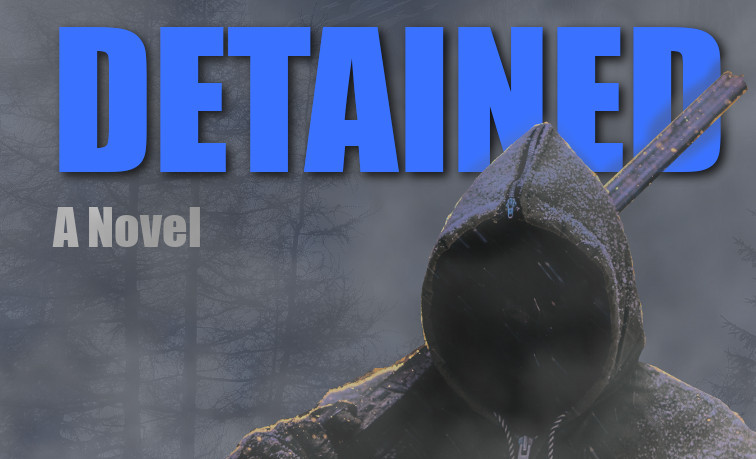Detained Chapter 14

I’ll be posting one chapter of my novel Detained every week throughout 2021. Download links below!
14. Mike
The crawlspace took longer than he’d expected. A second after the trap door was lowered softly behind him, it went pitch black and he smacked his head on a joist hard enough to send him spinning to the floor. He sat for a moment, head ringing, and when he shook it off he realized he was turned-around and had to force himself to pause and regain his bearings. He fished his phone from his pocket and thumbed the flashlight on.
The crawlspace was a disaster, The floor was dirt, uneven and littered with rocks and old cans and bottles. The whole place was layered in spider webs, and as he swept the light around a dozen small bodies scampered away. He was sitting hunched over and the floor joists scraped against the back of his head.
“Three feet my ass,” he whispered.
He started crawling, awkwardly holding the phone in one hand and trying to avoid the bottles and other sharp edges buried in the dirt. It was surreal and quiet under the bar; the moment the trap door had been lowered all the sound had muted down to nothing, and all he could hear was his own breathing and the crunch of the dirt and debris under him. He moved as quickly as he could, searching the subfloor above for signs of the second trap door.
It was surprising how quickly his sense of the physical space above faded away. It seemed impossible that the crawlspace was as large as it was—it went on long after he assumed he must be close to the back room. Being able to see only small areas with his phone contributed to the sense that the darkness went on and on, infinite and featureless.
And then there it was: The trapdoor leading up into the back room. He was sweating freely as he positioned himself under it, shining the light up to make sure he could see exactly where it was in relation to himself. Then he killed the light and pushed the phone back into his pocket. Rising up on his haunches, he put his hands flat against the panel and slowly lifted the door up, just as a commotion happened in the bar, shouts and the thud of feet on the floor carrying back to him.
He hesitated, listening. The shouting went on, but he couldn’t make any of it out. He considered turning back, creeping back up behind the bar, pretending that nothing had happened, but without knowing what he was crawling back to, it was too risky. The best way forward was to press the tiny advantage they’d managed to establish.
He waited another few heartbeats with the trap suspended above his head, listening and letting his eyes adjust. The air smelled damp and ripe, like stale beer. He was behind a shelf filled with cans and cardboard boxes. A wall of used kegs was on the other side, both barriers serving to shield him from the rest of the room.
The commotion in the bar had died down, and he could hear talking in the back room.
“—kind of weather you get up there?”
“All kinds, man. We got that saying: You don’t like the weather, just wait and it’ll change.”
“Four seasons in one day, huh?”
Jesus, he thought, they were chatting, getting to know each other. Haggen sounded relaxed, even, like he wasn’t worried about anything.
Slowly, Mike lifted the trap up, standing slowly as he did so. His head swam a little as he straightened up, and for one panicked moment he thought he might pass out. Then everything firmed up. He could see through the shelves that Haggen’s restraints had been adjusted; his wrists and ankles were still bound but he wasn’t hogtied. He sat more or less comfortably on the floor, and gave every indication he was unworried, confident, and possibly enjoying himself. Mike found himself liking this guy a lot. He knew that under normal circumstances they would have hated each other, they would have been the sort of guys who were unable to go five minutes without starting an argument. But somehow the alchemy of being in this incredible situation had changed the whole dynamic.
The guard, Warner, stood with his back to the door. He wasn’t holding his sidearm, but Mike thought his posture could be described as ready. He seemed friendly and just as confident and comfortable as Haggen, but was obviously not going to let that interfere with guarding the man as he’d been ordered. Mike was impressed in spite of himself. Some guys could either be friendly or they could be ready. Not many could be easygoing and chatty without sacrificing their situational awareness.
As his eyes got used to the dim light, he scanned the rest of the room. It was an all-purpose supply closet he was surprised had passed a health inspection, assuming they bothered with such things when you were as far off the road as McCoy’s place. Dry food, kegs, bottles, condiments, boxes of napkins and other equipment were stacked all over the place.
After a moment’s searching, he saw the crossbow. It had been hung on the wall behind Haggen, along with a few other items: A bright orange vest, a green canvas backpack, and a sheathed hunting knife that hung by its own separate strap. He couldn’t see any bolts for the bow, but he assumed they would be in the backpack.
There was no sneaking it out. He was going to have to take out the guard, quietly.
He scanned the room again. There was no way to sneak up on Warner; he would have to come from around the shelves, putting him squarely in the soldier’s peripheral vision. Even if he manged to get the jump on him, there would be time for him to yell, to attack, to make noise.
When he looked back at Haggen he jumped, because Haggen was staring right at him, still talking. He winked, then turned back to face Warner as if nothing had happened.
“Dude, you mind if I stood up? My ass is asleep!” Haggen said, all aw-shucks hick charm.
Warner hesitated. Mike imagined he was running through the possible interpretations of his orders. Mike had never served in the military, but he’d known plenty of people who had, and he knew the one overarching fact of life in a military unit of any kind was obeying orders issued from the legitimate chain of command was not optional.
But what was legitimate? Mike had the idea that this was an unusual unit, in an unusual circumstance. From the shadows, he watched Warner’s face as he worked through the implications.
“All right,” he finally said, laying a hand on his sidearm. “I won’t help you. If you can stand without assistance, and stay right where you are, I won’t object.”
“Cool,” Haggen said. With what Mike thought was transparently theatrical effort, he struggled to get to his feet. When he was upright but still clinging to the shelf for support, he spun away and sailed into Warner.
“Oh, shit, I’m sorry!”
Warner caught Haggen by instinct, and Haggen grabbed onto his shoulders and spun him slightly so his back was turned. Mike moved immediately, running and launching himself at the pair, wrapping one arm around Warner’s neck and slapping his other hand on the soldier’s mouth. For a few moments the three of them struggled in near-silence, with the only noise being heavy breathing and grunts, the scraping of their shoes on the floor.
For one horrible moment, Mike thought Warner was going to break free. The kid was strong. Haggen, unbalanced by his ankle bonds, had both hands planted on Warner’s sidearm,. preventing him from drawing it while Mike choked him with an imperfect, rushed hold.
Slowly, Warner weakened, and finally slumped his weight against Mike, who strained something in his back desperately stopping them all from falling with a loud crash to the floor. Gently giving in to gravity, the three of them sank down until he and Haggen were sprawled, panting, on either side of the soldier.
“You a wrestler, too?” Haggen said between gasps.
“Was,” Mike said, sitting up and rubbing his arm. “For a few months.”
“I gotta become a millionaire and travel the world taking lessons,” Haggen added, slowly climbing to his feet. “It’s got benefits. What’s the plan?”
Mike got up and plucked the crossbow, backpack, and knife from the wall. He dropped the bag and bow and pulled the knife from the sheath, using it to cut Haggen’s bonds. “Grab his sidearm.” He looked around. “Does he have more zipties on him?”
Haggen stuffed the gun into his waistband after checking the safety and then searched Warner’s pockets. “Yup,” he said, brandishing a fistful of black plastic ties.
“Let’s get him up and tie him by the wrists to the shelf here, so it looks like he’s standing,” Mike said. “Then you get the bow and bag out of the way and wait here, look like you’re still bound, just in case anyone just pops their head in here. I’m going back through the crawlspace to the bar, and Jack is coming back through. he’ll take the crossbow, and then the two of you are coming down the hall, and we’re taking them all down. We’re taking the bar.”
Haggen met his eyes and held them, face slowly breaking into a grin. “Hot damn, when you first walked in I thought you were an asshole tourista,” he said. “I’m declaring you an honorary citizen of One-Eyed Jack’s.”
Mike smiled back. “It’s an honor.” He walked over and dropped back into the crawlspace, crouching down. “Don’t start anything unless you have to,” he said. “The longer we put this off, the better our advantage.”
Haggen nodded, bringing the bag and bow over and dropping them on the floor. “Got it. I can improv the shit out of this, don’t worry.”
Mike nodded and disappeared under the floor. A moment later he popped up again. “Haggen: This is all about surprise. We’ve got a handgun and a crossbow. We’ll try our best to help out in the bar, but it’s gonna be you and McCoy making the difference. McCoy’s skittish about killing people and he’s going to go for non-fatal shots to incapacitate.”
Haggen nodded. “You think I should too?”
Mike’s expression was neutral. “I think you know if we fuck this up, we’re all going to be hogtied in here until they decide what to do with us. And they’re going to be irritated if we injure or kill some of them. I guess all I’m saying is, we gotta make this count.”
Haggen nodded. “Got it.” Then he grinned. “Kill ’em all.”




